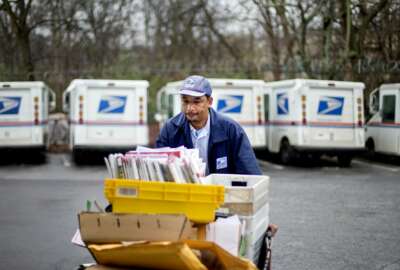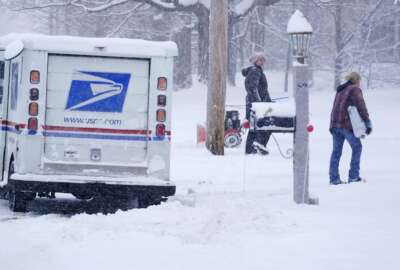DeJoy says USPS ‘winning new customers’ amid increased package volume
The Postal Service says its competitive package business is growing, following its busy year-end holiday season.
The Postal Service says its competitive package business is growing, following its busy year-end holiday season.
USPS says it delivered 130 million more packages in the “peak” first quarter of fiscal 2024, a nearly 7% increase, compared to the same period last year.
USPS delivered more than 1.9 billion packages in the first quarter of fiscal 2023, which covers October through the end of December.
Postmaster General Louis DeJoy, in a video message to employees, said growing the package business is the key to turning around the Postal Service’s long-term financial problems.
“This shows that we are winning new customers, winning more volume from existing customers and reclaiming market share in the package business that we surrendered long ago,” DeJoy said Thursday.
DeJoy said last November during a USPS Board of Governors meeting that the agency will continue to push for a “growing share” of a package business that competes with private-sector shippers. He said USPS is looking to grow its package revenue by $1 billion by the end of fiscal 2024.
To keep up with the goals of its 10-year reform plan, DeJoy said USPS needs to cut costs by about $3 billion over the next 18 months and grow its revenue by at least the same amount.
USPS is looking to save on costs through sweeping changes to its transportation and delivery network. That includes standing up Sorting and Delivery Centers (S&DCs), large facilities that bring mail processing and mail delivery operations all under one roof.
USPS planned to have 30 S&DCs running by the end of 2023, and about 100 S&DCs running by the end of 2024.
“Our journey is complicated and will not be without risk or error. But I know we can push through and succeed, if we simply keep working together to rapidly improve and grow our business,” DeJoy said. There is no alternative, and we must move forward with our priorities and our focus.”
DeJoy said USPS delivered mail and packages in the first quarter of FY 2024 “with respectable service performance.”
It delivered 85.4% of first-class mail on time, a nearly 6% decrease compared to the same period last year.
“We did so with fewer planes, fewer trucks, fewer buildings and fewer work hours than we used last year, even though we had higher volume and we’re undergoing significant transition activities,” DeJoy said.
About 98% of the American public, he added, is receiving their mail and packages within three days, and that 50% of mail and packages are delivered a day ahead of its service standard.
“That is not perfection, but it is stability and a baseline to improve from in a cost-effective and deliberate manner — and that is what we will do,” DeJoy said.
DeJoy pointed to higher package volume amid its cost-cutting efforts as a sign that USPS operations are improving under its 10-year “Delivering for America” reform plan.
USPS, however, reported a $6.5 billion net loss for fiscal 2023, and expects to see a similar loss for FY 2024.
“We need to fix this,” DeJoy said.
Under its 10-year Delivering for America (DFA) plan, USPS expected it could “break even,” and start to dig out from years of billion-dollar net losses by this point.
To stay on pace with its reform goals, DeJoy said USPS needs to keep rolling out new products “that we believe every person in business would rather use, than those of our competitors — not just today, but far into the future.”
USPS last summer rolled out Ground Advantage, a new two-to-five-day delivery service for packages that weigh less than 25 pounds. DeJoy said the launch of Ground Advantage contributed to the nearly a 7% increase in package volume last quarter.
He also called for an “increasing pace” to network modernization plans and reducing the cost of delivering each piece of mail and every package.
DeJoy, however, stressed the need for USPS to dig itself out of its long-term financial challenges on its own, and not rely on financial support from Congress.
“We are laser-focused on transforming our organization, because we know the terrible, ultimate consequences of not covering our costs and potentially needing to go to Congress, hat in hand, every year to get our funding through the congressional budget process — for our investments, for our supplies, for our payroll,” DeJoy said.
The 1970 Postal Reorganization Act separated USPS — formerly the U.S. Post Office Department — out from the congressional budget process and removed the agency from the president’s cabinet.
Since then, USPS has been largely self-funded through its own revenue. Congress, however, provided major financial assistance in recent years.
Congress granted USPS $10 billion in emergency aid at the height of the COVID-19 pandemic, when the agency was a risk of running out of cash.
Lawmakers also granted $3 billion in the Inflation Reduction Act to help USPS afford a nearly $10 billion investment in a mostly electric next-generation delivery vehicle fleet and charging stations.
Congress also passed the Postal Service Reform Act in 2022, which eliminated a requirement to pre-fund its retiree health benefits well into the future. USPS made the law its only legislative ask in its 10-year reform plan.
Lawmakers expect the legislation would save USPS a total of $107 billion — with more than half of those savings going into effect immediately, by forgiving $57 billion in deferred payments to its retiree health benefits fund.
DeJoy said ongoing changes at USPS represent the “largest organizational transformations that is occurring in any organization anywhere in the nation.”
“There are many opinions about how the Postal Service should operate, where it should operate, what it should do and not do,” DeJoy said. “But none of these opinions come from anyone that has the responsibility, or the competency, for determining how to transition from where we were to a high-quality service, while also ensuring our financial self-sufficiency. That responsibility was assigned by Congress to us, and that is what we are setting out to do.”
Copyright © 2025 Federal News Network. All rights reserved. This website is not intended for users located within the European Economic Area.
Jory Heckman is a reporter at Federal News Network covering U.S. Postal Service, IRS, big data and technology issues.
Follow @jheckmanWFED






